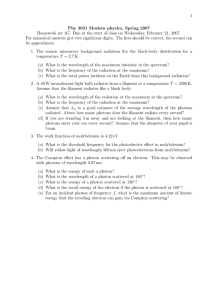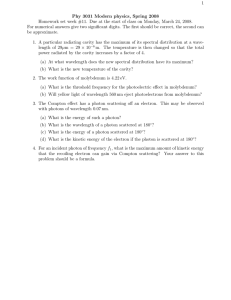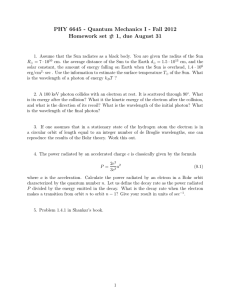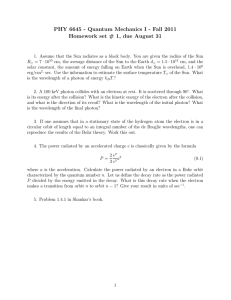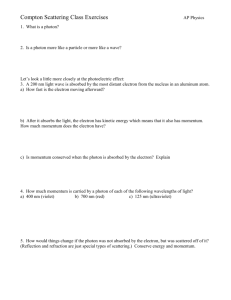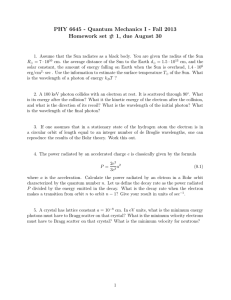Chapter 3 Physics 205 Solution of Home Work Problems
advertisement
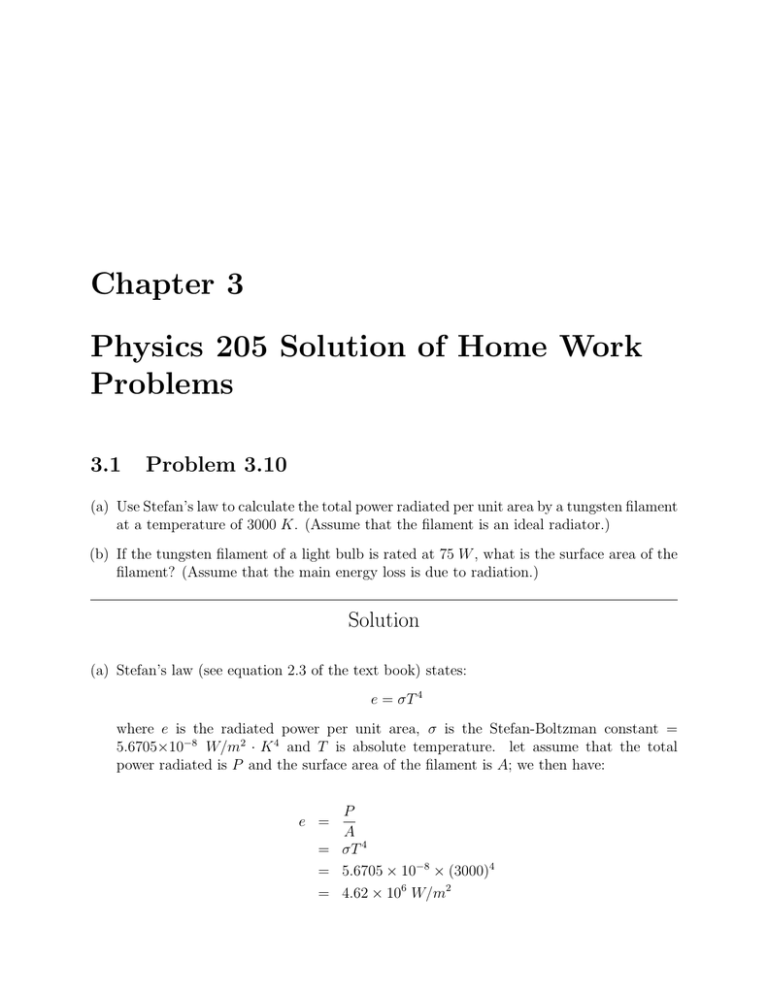
Chapter 3 Physics 205 Solution of Home Work Problems 3.1 Problem 3.10 (a) Use Stefan’s law to calculate the total power radiated per unit area by a tungsten filament at a temperature of 3000 K. (Assume that the filament is an ideal radiator.) (b) If the tungsten filament of a light bulb is rated at 75 W , what is the surface area of the filament? (Assume that the main energy loss is due to radiation.) Solution (a) Stefan’s law (see equation 2.3 of the text book) states: e = σT 4 where e is the radiated power per unit area, σ is the Stefan-Boltzman constant = 5.6705×10−8 W/m2 · K 4 and T is absolute temperature. let assume that the total power radiated is P and the surface area of the filament is A; we then have: P A = σT 4 = 5.6705 × 10−8 × (3000)4 = 4.62 × 106 W/m2 e = 2 CHAPTER 3. PHYSICS 205 SOLUTION OF HOME WORK PROBLEMS (b) The surface area of the filament that is rated at 75 W , is given by: A = P e 75 4.62 × 106 = 1.62 × 10−5 m2 = 16.2 mm2 = 3.2. PROBLEM 3.23 3.2 3 Problem 3.23 The average power generated by the sun has the value 3.74 × 1026 W . Assuming the average wavelength of the Sun’s radiation to be 500 nm, find the number of photons emitted by the sun in 1 s. Solution Each photon carries an amount of energy of hν = hc/λ, where h is Planck’s constant = 6.63×10−34 J · s, ν is the frequency and λ the wavelength of the photon’s radiation. The power P radiated by the Sun is 3.74×1026 W or 3.74×1026 J/s at an average wavelength of λ = 500 nm, the number of photons emitted in 1 s, n/t is then: n P = photon/s t hν Pλ = hc 3.74 × 1026 × 500 × 10−9 = 6.63 × 10−34 × 3 × 108 = 9.40 × 1044 photon/s 4 3.3 CHAPTER 3. PHYSICS 205 SOLUTION OF HOME WORK PROBLEMS Problem 3.28 A light source of wavelength λ illuminates a metal and ejects photoelectrons with a maximum kinetic energy of 1.00 eV . A second light source with half the wavelength of the first ejects photoelectrons with a maximum kinetic energy of 4.00 eV . What is the work function of the metal? Solution The maximum kinetic energy Kmax is given by: Kmax = hν − φ hc = −φ λ we then have, for the two cases: hc −φ λ1 hc = −φ λ2 K1max = K2max Since λ2 = 12 λ1 and the metal is the same we then get: hc − K1max λ1 hc = − K2max λ2 hc = 2 − K2max λ1 φ = (3.1) (3.2) Using Equations (2.1) and (2.2) we get: hc hc − K1max = 2 − K2max λ1 λ1 or K2max − K1max = and λ1 = hc λ1 hc K2max − K1max (3.3) 3.3. PROBLEM 3.28 5 Substitution for λ1 from Equation (2.3) into equation (2.1) we get: φ = hc hc K2max −K1max − K1max = K2max − 2K1max = 4.0 − 2.0 = 2.0 eV 6 CHAPTER 3. PHYSICS 205 SOLUTION OF HOME WORK PROBLEMS 3.4 Problem 3.37 X-rays with an energy of 300 keV undergo Compton scattering from a target. If the scattered rays are detected at 30◦ relative to the incident rays, find: (a) The compton shift at this angle, (b) The energy of the scattered X-rays, and (c) The energy of the recoiling electron Solution (a) The Compton shift ∆λ is given by: ∆λ = λ0 − λ◦ h (1 − cos θ) = me c hc (1 − cos θ) = me c2 1.240 × 103 (eV · nm) = (1 − cos 30◦ ) 511 × 103 (eV ) = 3.25 × 10−4 nm Where λ◦ is the wave of the incident X-rays and λ0 is the wave of the scattered X-rays. (b) We calculate the wavelength λ0 of the scattered x-rays as: E◦ = λ◦ = λ0 = = = = = hc λ◦ hc E◦ λ◦ + ∆λ hc + ∆λ E◦ 1.240 × 103 (eV · nm) + 3.25 × 10−4 (nm) 3 × 105 (eV ) 4.458 × 10−3 nm 4.458 × 10−12 m 3.4. PROBLEM 3.37 7 The energy E 0 of the scattered X-rays is: hc λ0 (4.14 × 10−15 eV · s)(3 × 108 m/s) = 4.458 × 10−12 m = 2.79 × 105 eV = 279 keV E0 = (c) The recoiling electron energy Ee can be calculated from consideration of energy conservation. E◦ = E 0 + Ke Ke = E◦ − E 0 = 300 − 279 = 21 keV 8 CHAPTER 3. PHYSICS 205 SOLUTION OF HOME WORK PROBLEMS 3.5 Problem 3.43 ◦ In a Compton collision with an electron, a photon of violet light (λ = 4000 A) is back scattered through an angle of 180◦ . (a) How much energy (eV ) transferred to the electron in this collision? (b) Compare your result with the energy this electron would acquire in a photoelectric process with the same photon. (c) Could violet light eject electrons from a metal by Compton collision? Explain. Solution (a) The energy ∆Ee transferred to the electron can be calculated from the Compton shift, i.e. ∆λ = λ0 − λ◦ hc = (1 − cos θ) me c2 hc = 2 me c2 1.240 × 103 (eV · nm) = 2 511 × 103 eV = 4.85 × 10−3 nm Since E= hc λ then hc ∆E = − ∆λ λ2 1.240 × 103 (eV · nm) ∆Ee = × 4.85 × 10−3 nm 2 2 (400) nm = 3.76 × 10−5 eV 3.5. PROBLEM 3.43 9 (b) In photoelectric effect, the photon give all its energy to the electron, i.e. hc λ 1.240 × 103 (eV · nm) = 400 nm = 3.1 eV Ephoto = Comparing Compton scattering energy transfer to photoelectric energy transfer we get: 3.76 × 10−5 ∆Ee = Ephoto 3.1 = 1.21 × 10−5 (c) By comparing the results of Problem (2.19) and Problem (2.37a), we conclude that the answer is no. Problem (2.19) shows that a typical work-function of a metal is about 2 eV while Problem (2.37a) shows that the maximum energy given to an electron by an ultraviolet photon in Compton scattering is 3.76 × 10−5 eV

